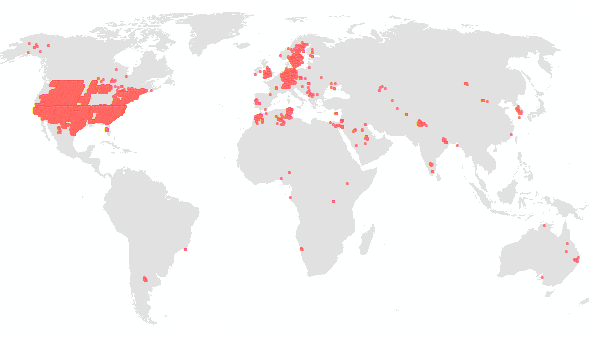Considering water as the primary resource necessary for social life, agriculture, industry, and wealth, the importance of groundwater investigation is clear. Apart from many other pollutants, this work focusses on geogenic uranium (U) and radium (Ra), which both stand for natural radionuclides (NORM) that need to be considered frame of groundwater exploration and monitoring programmes due to their specific mobility and chemo-/radiotoxicity. As investigation of U and – to a lesser extent - Ra is done by an increasing number of scientific working groups, the global dataset is improving continuously. In order to give a summarized overview on available and recent literature, scientific papers, reports, and governmental documents have been reviewed for U-238 mass concentrations and Ra-226 and Ra-228 activity concentrations and collected in tables and global maps. Further natural isotopes of U and Ra have been rarely subject of investigation. The collected data were evaluated and interpreted in frame of an associated scientific publication (see citation). From the available data it can be concluded that high geogenic U occur mainly under oxidizing conditions and carbonate rich groundwater, which might be seen as indicator for elevated U concentrations. Certain geological formations, as for example sedimentary, granitic, and volcanic host rocks, promote high U concentrations in groundwater. For geogenic Ra, the search for definite indications proved difficult, since less clear correlation is given for any observed factor. In a global perspective, the most promising evidence for elevated Ra are highly reducing redox conditions, as well as the occurrence of Fe/Mn mineral phases. Furthermore, barite represents a sink for Ra due to its ability to incorporate Ra isotopes. Dissolution of those mineral phases eventually results in co-dissolution of Ra, when Ra is found in host rocks of investigated aquifers, or downstream of such groundwater reservoirs. Furthermore, cation exchange might enhance Ra mobility process, especially in case of sedimentary aquifers with low sorption capacity and/or aquifers with high salinity. Given those chemical requirements for the occurrence of U and Ra, a negative correlation between mother and daughter nuclide can be established. When knowledge on present geological and geochemical constraints is available, elevated U and Ra concentrations might be predictable, as long as anthropogenic influence is excluded. Die Überwachung der Grundwasserqualität ist angesichts der Bedeutung von Grundwasserressourcen als Lebensgrundlage kontinuierlich zu gewährleisten und zu optimieren. Diese Veröffentlichung fokussiert die Bedeutung von natürlich vorkommenden geogenen Radionukliden (NORM) und deren Relevanz für die Nutzung von Grundwasserressourcen. Die geogen vorkommenden Radionuklide von Uran (U) und Radium (Ra) sind NORM die aufgrund Ihrer Mobilität und Chemo-/Radiotoxizität eine besondere Bedeutung haben. Die hier dargestellten Daten wurden aus zugänglicher Fachliteratur, wie wissenschaftlichen Publikationen und Fachberichten, entnommen und veranschaulichen insb. die Verbreitung von im Grundwasser gelösten U-238 (Gewichts-Konzentration) sowie Ra-226 und Ra-228 (Aktivitäts-Konzentration). Weitere natürlich auftretende Isotope von U und Ra wurden in der Literatur nur selten erfasst. Die Erhebung und Auswertung der dargestellten Daten Dritter erfolgte im Rahmen einer begleitenden Publikation (s. Quellennachweis). Nach den verfügbaren Daten treten hohe geogene U-Gehalte im Grundwasser hauptsächlich unter oxidierenden Redox-Bedingungen auf, wobei hohe Karbonat-Gehalte als Indikatoren für erhöhte gelöste U- Gehalte gelten. Darüber hinaus werden erhöhte gelöste U-Gehalte insbesondere in sedimentären, granitischen und vulkanischen Grundwasserleitern angetroffen. Die deutlich schlechtere Datenlage zur Verbreitung von gelöstem Radium im Grundwasser macht die Formulierung von übergreifenden Indikatoren, die zu einer Anreicherung von Ra im Grundwasser führen, schwieriger. Im globalen Kontext treten erhöhte Ra-Nuklide unter stark reduzierenden Redox-Bedingungen und der Verfügbarkeit von Fe/Mn-Mineralphasen auf. Ferner kann Barit aufgrund der chemischen Ähnlichkeit von Ba und Ra signifikante Ra-Gehalte in das Kristallgitter einbauen. Die Lösung dieser Phasen führt vermutlich zur Co-Lösung von Ra, falls Ra im Muttergestein der betreffenden Grundwasserleiter bzw. im Anstrom vorkommt. Neben der reduktiven Lösung wird auch Ionenaustausch als relevanter Freisetzungsprozess angenommen, der insbesondere in sedimentären Grundwasserleitern mit geringer Sorptionskapazität (Sandstein, Kalkstein) sowie bei hohem Lösungsinhalt relevant ist. Diese unterschiedlichen Mobilisationspfade von U und Ra Isotopen führen oft zu einer negativen Korrelation zwischen Mutter- (U) und Tochternuklid (Ra-226). Ein präzisiertes Verständnis der geologischen und geochemischen Rahmenbedingungen erlaubt die Identifikation von Grundwasserleitern mit erhöhten gelösten U- und/oder Ra-Gehalten und gezielte Untersuchungen sowie Gegenmaßnahmen im Sinne einer sicheren Trinkwasserversorgung.





